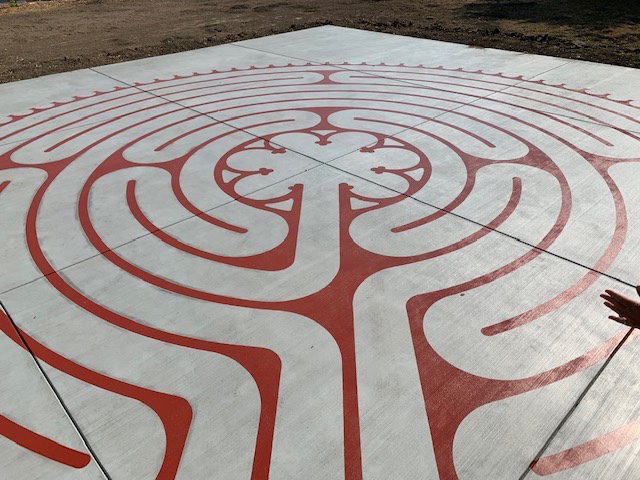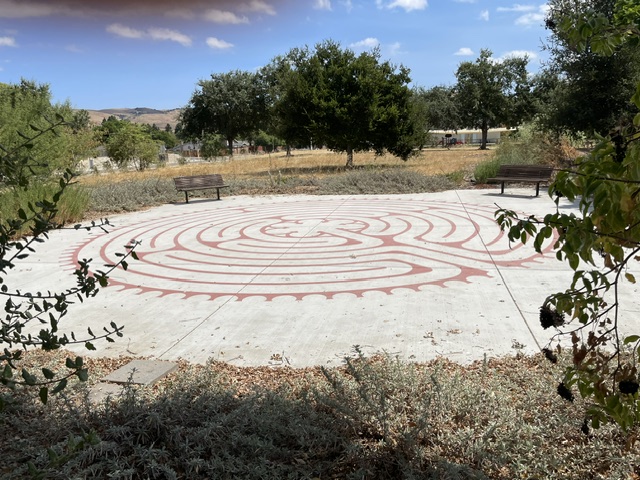Walking Labyrinth

Open 24 hours each day as a gift to the community from St. Stephen’s in-the-Field Episcopal Church.
Some History
Labyrinths in varying styles have been found in many cultures, on most continents, and date as far back as 4,000 BC. These days, many folks all over the world are walking in circles to seek answers to Life’s questions, to solve a problem, to seek the Divine and/or deepen their own spiritual path or spiritual knowing. The circles they walk are called labyrinths, whether it be a classic 5-8 circuit or the lovely 11 circuit Chartres (Medieval) pattern or the modified 8 circuit medieval pattern offered in this courtyard.
Labyrinths are based on sacred geometry that offers a balanced and serene environment for the soul. In the Middle Ages, labyrinths were walked as a pilgrimage or the celebratory ending of a pilgrimage journey.
Labyrinths were rare in Western culture until early in the 1990s when The Rev. Dr. Lauren Artress introduced the Chartres labyrinth in Grace Cathedral in San Francisco as a spiritual tool for healing and wholeness of mind, body, and spirit. Since that time, labyrinths have been popping up all over the world in churches, parks, hospitals, prisons, universities, and public buildings.
For more information, please see:
“Walking a Sacred Path: Rediscovering the Labyrinth as a Sacred Tool”, by The Rev. Dr. Lauren Artress, Riverhead Books, 1995.
“Rediscovering the Labyrinth” a 30-minute documentary video by The Rev. Dr. Lauren Artress at Grace Cathedral: www.gracecathedral.org/labyrinth
See also: https://www.veriditas.org


Approaches to the Labyrinth
There are many ways to approach and walk a labyrinth. First, there is no right or wrong way. Second, a labyrinth is not a maze. There is only one way in and one way out. By simply putting one foot in front of the other, the path will lead you. You might pause at the entrance, take a few deep breaths, and focus on an idea, a question, or use a mantra to quiet the “busy mind”. This could be a word or phrase, such as: Be still… Love… Peace…
Tradition recommends three optional stages of the walk. On the way in. . . .
- Purgation (Releasing) ~ A releasing, a letting go of the details of your life. This is the act of shedding thoughts and distractions. A time to open the heart and quiet the mind.
- Illumination (Receiving) ~ When you reach the center, stay there as long as you like. It is a place of meditation and prayer: Receive what is there for you to receive.
- Union (Returning) ~ As you leave, following the same path out of the center as you came in, you enter the third stage, which is joining the Divine, God, your Higher Power, or the healing forces at work in the world. Each time you walk the labyrinth you become more empowered to find and do the work you feel your soul reaching for.
Guidelines for the walk: Quiet your mind and become aware of your breath. Allow yourself to find the pace your body wants to go. The path is two ways. Those going in will meet those coming out. You may “pass” people or let others step around you. If your pace is faster or slower than others, you can pause at a turn or you might take a turn a bit early. Do what feels natural. After your walk, it may be helpful to write or draw something about your experience. You might want to talk with a labyrinth facilitator or friend.
May you be blessed from your experience with our labyrinth. Please come again and invite others.
The St. Stephen’s Labyrinth was built in memory of Edith “Edy” Unthank who was a long-time parishioner and the long-time dreamer and inspiration for this project.
